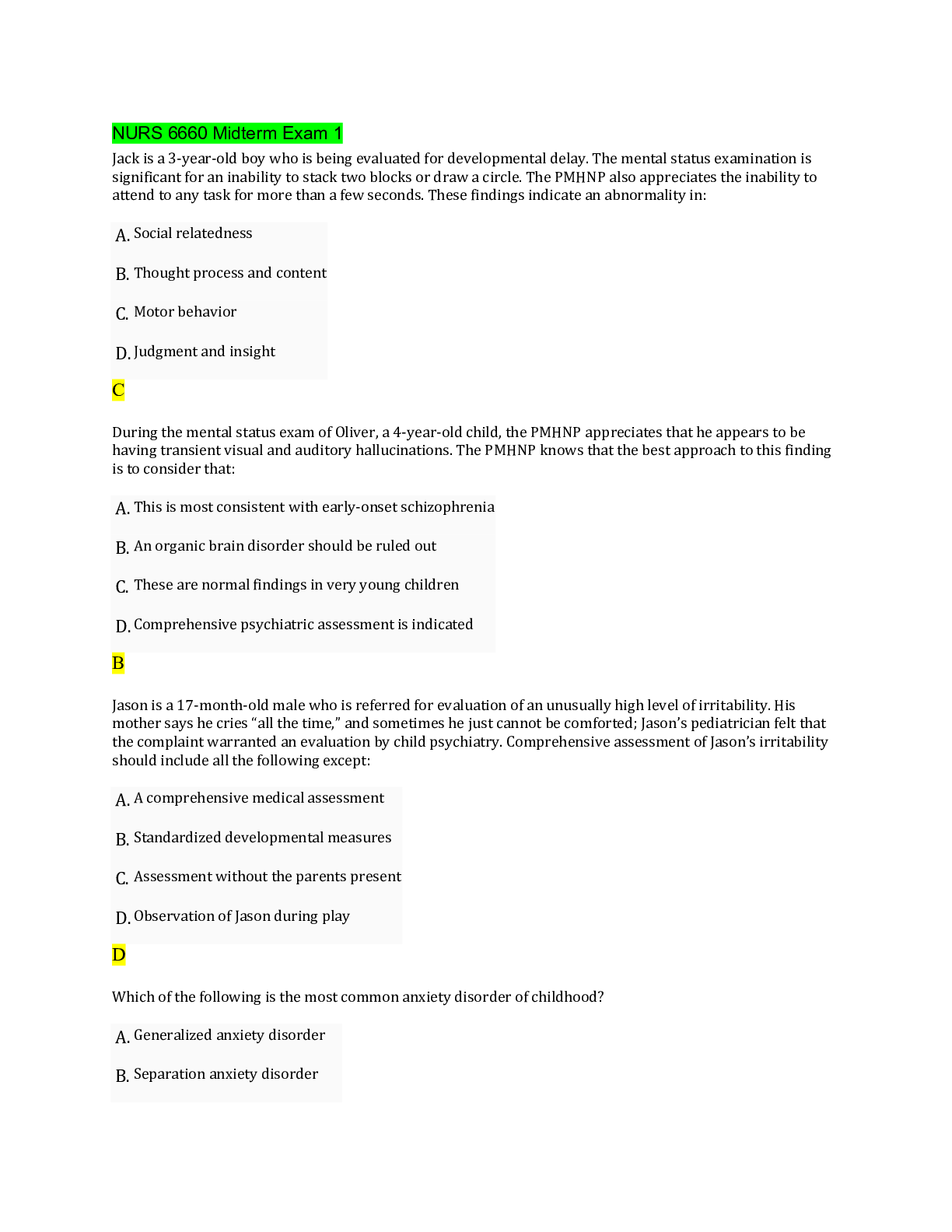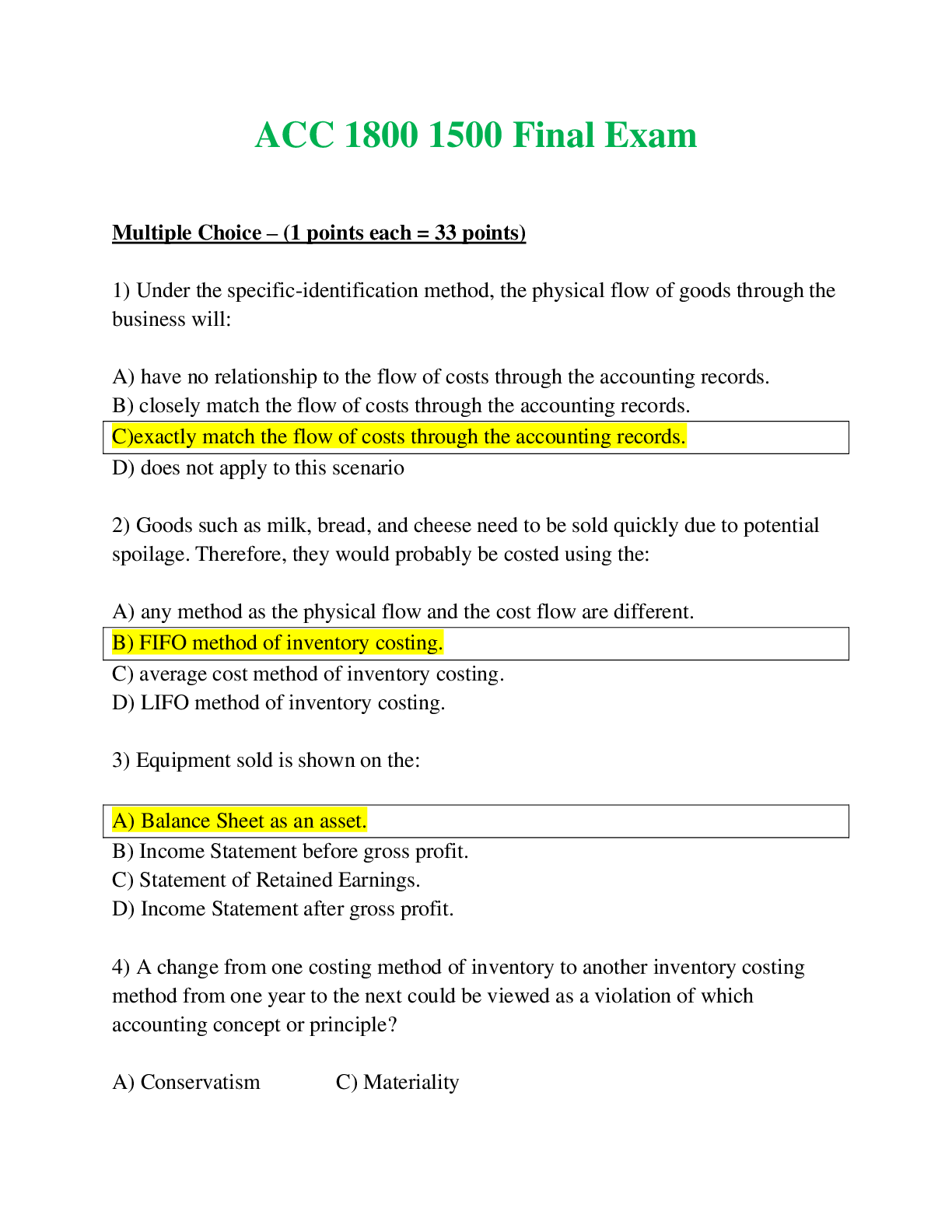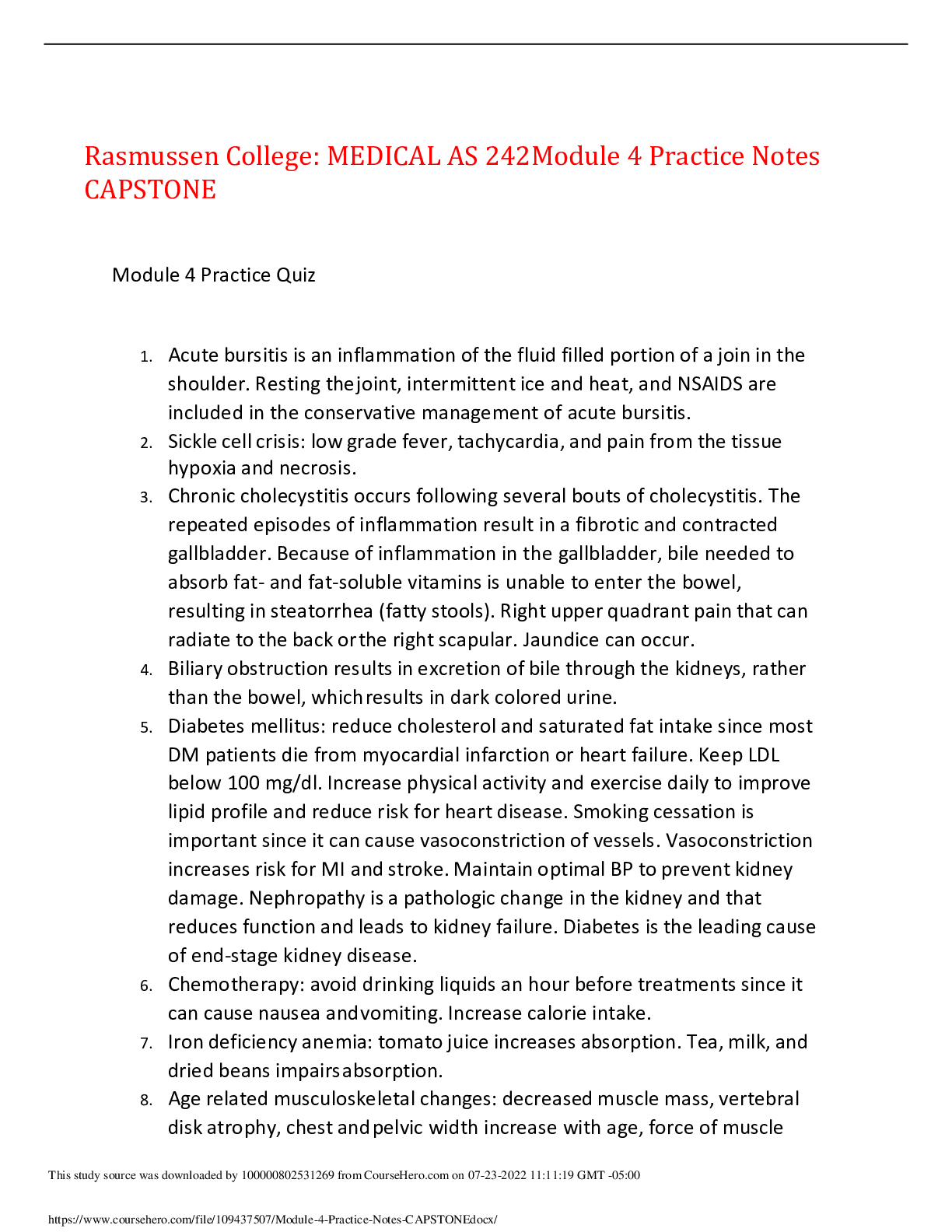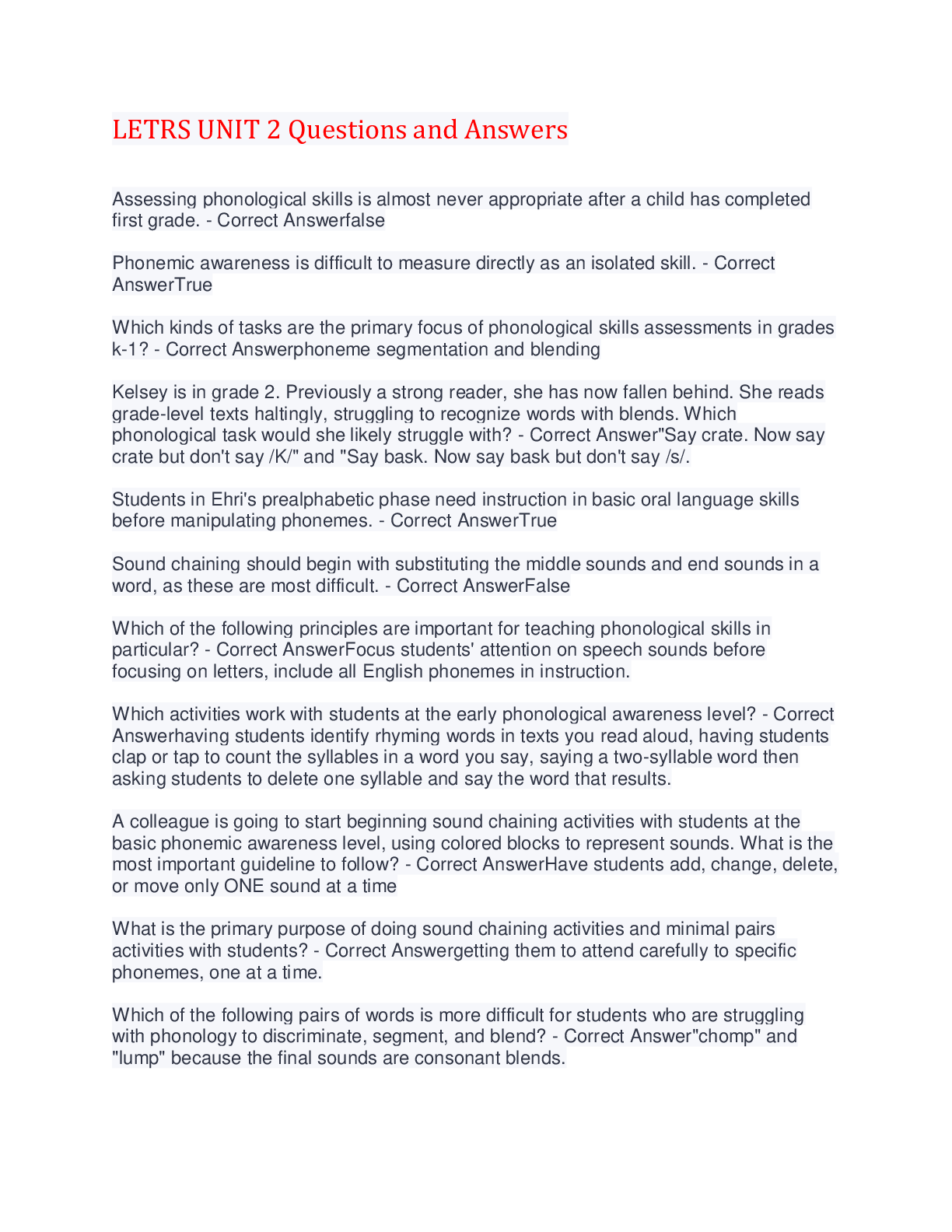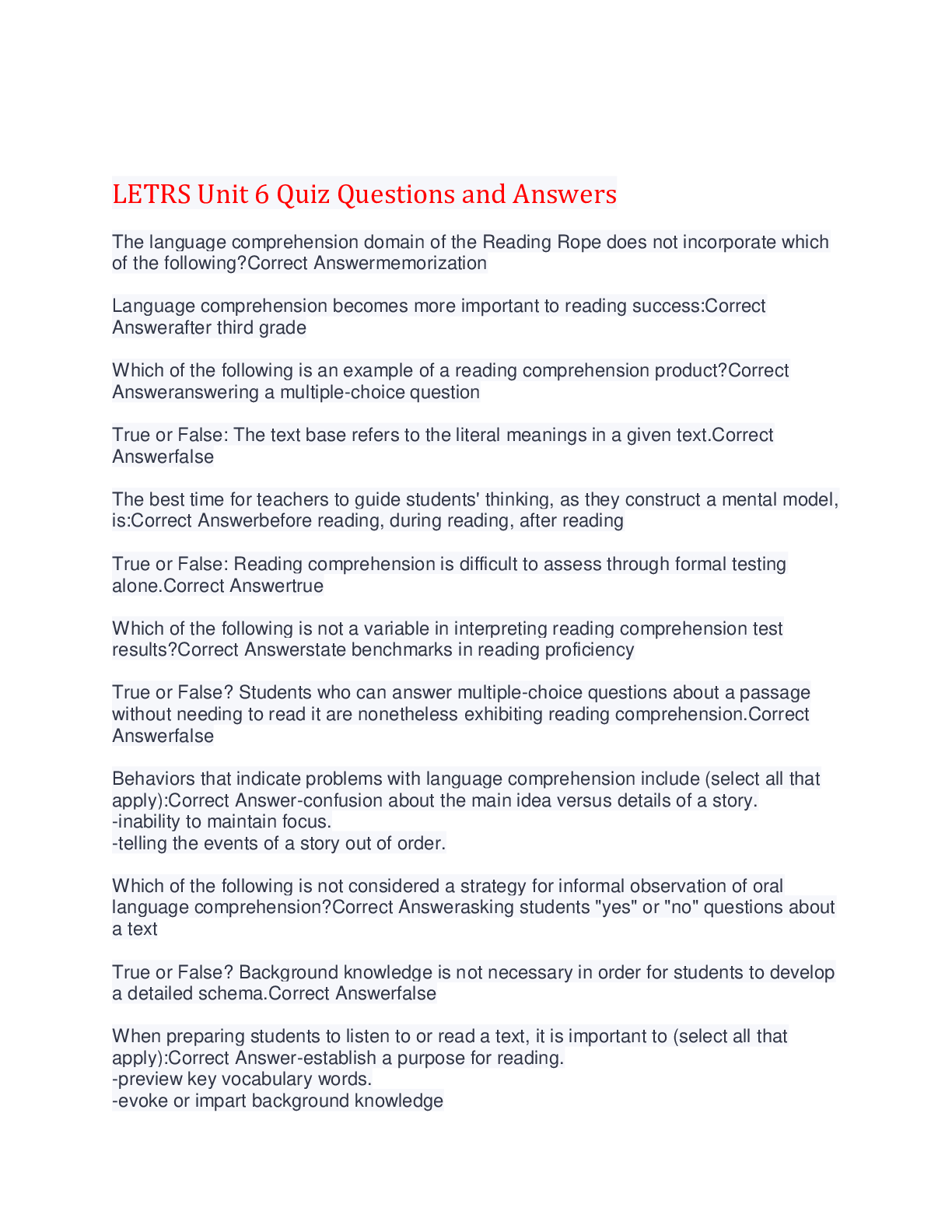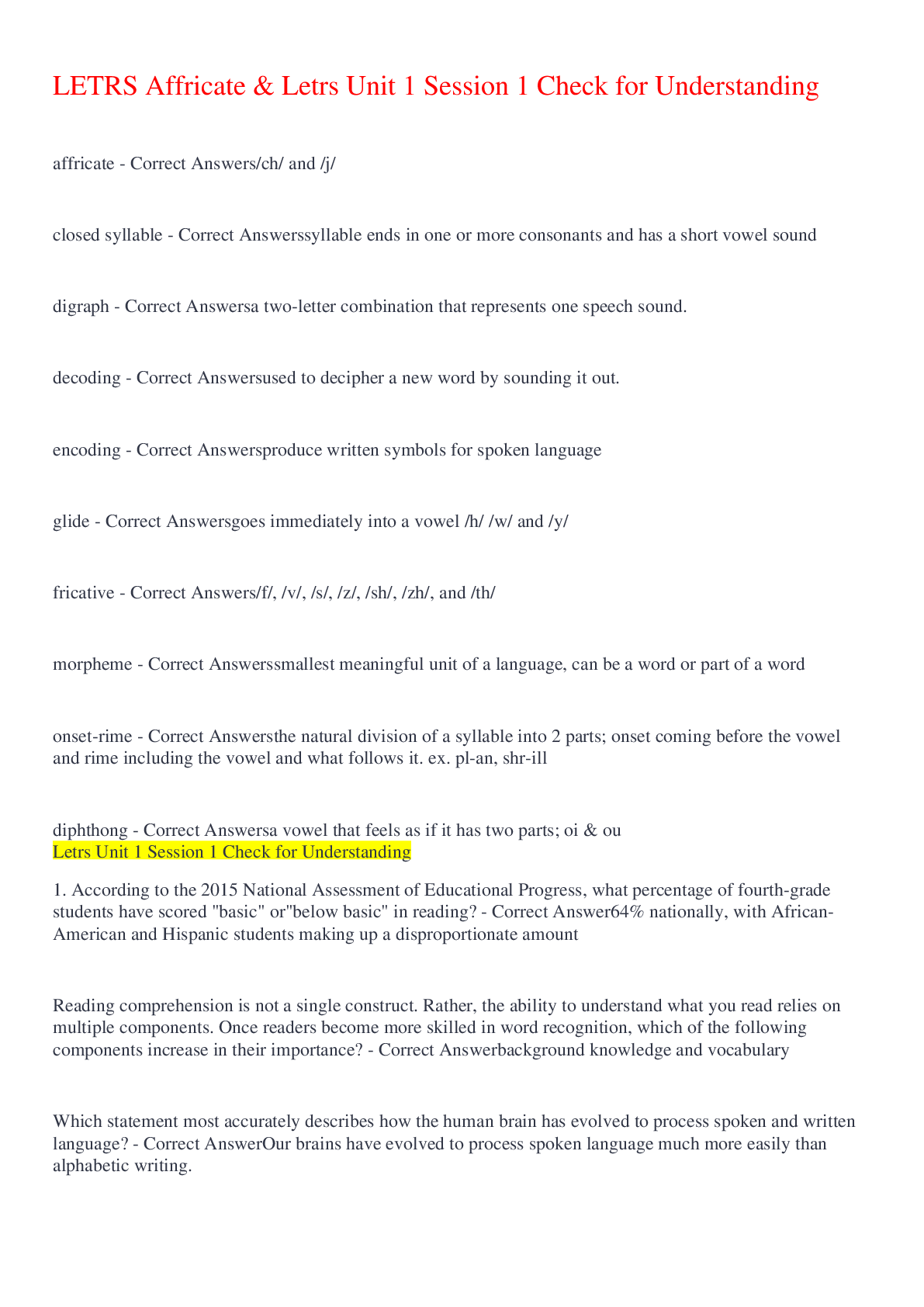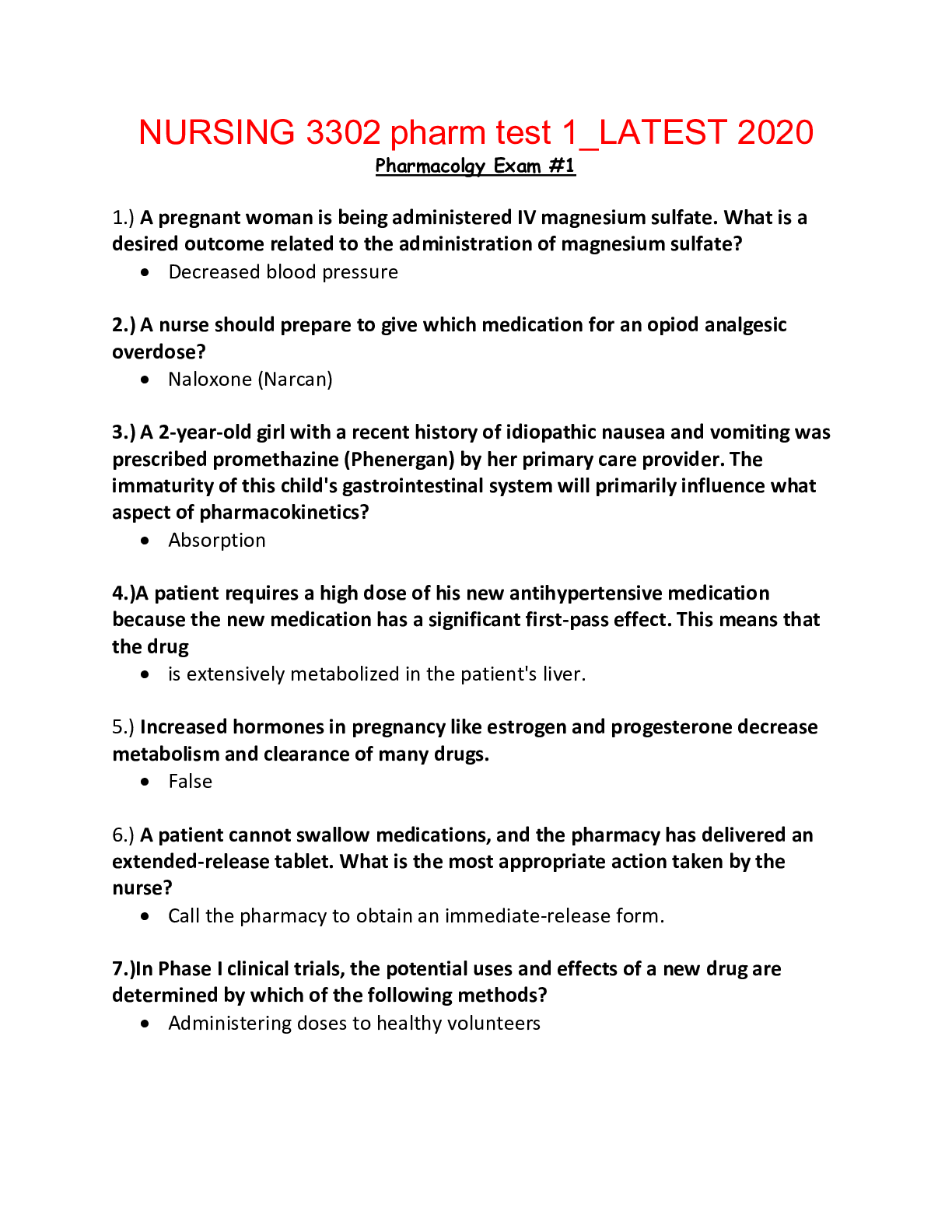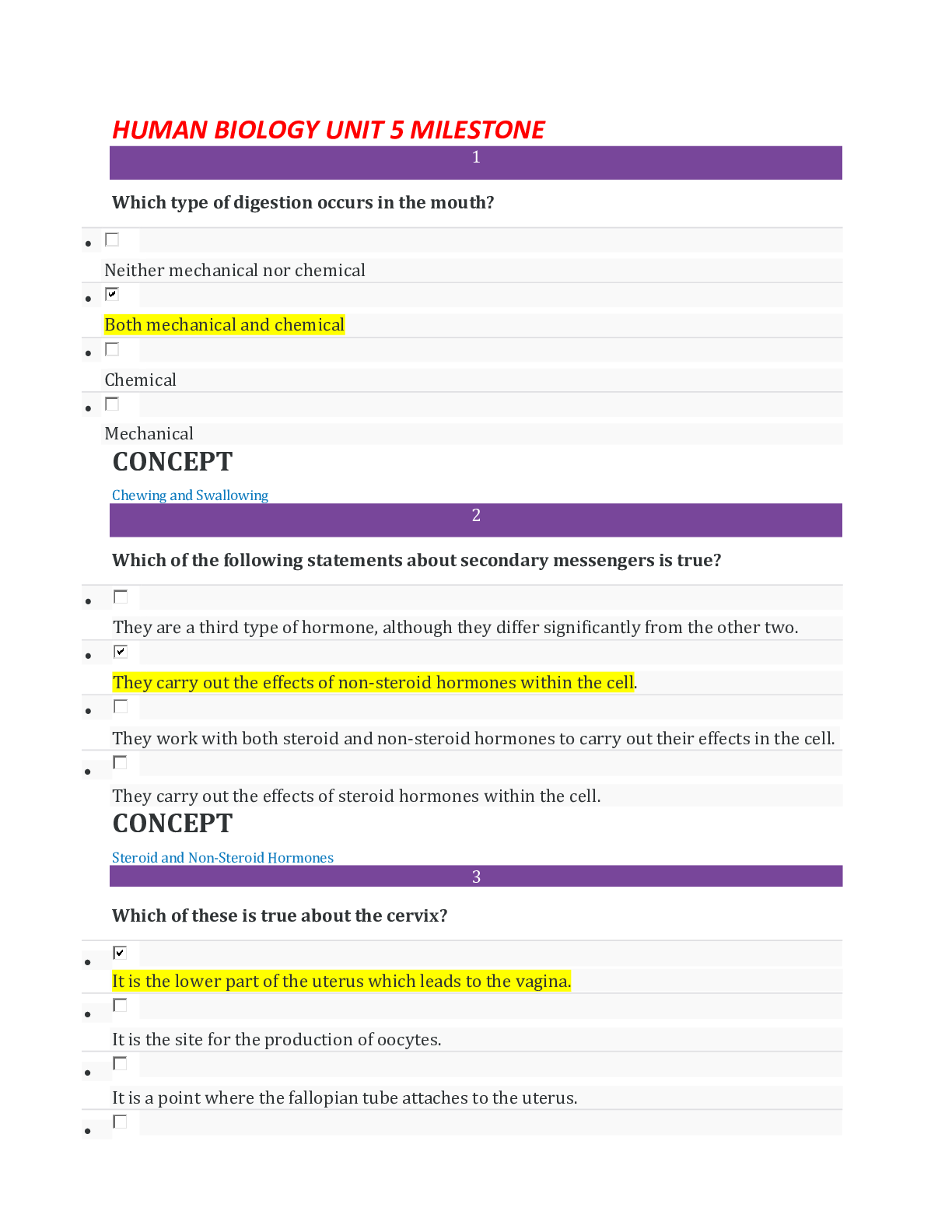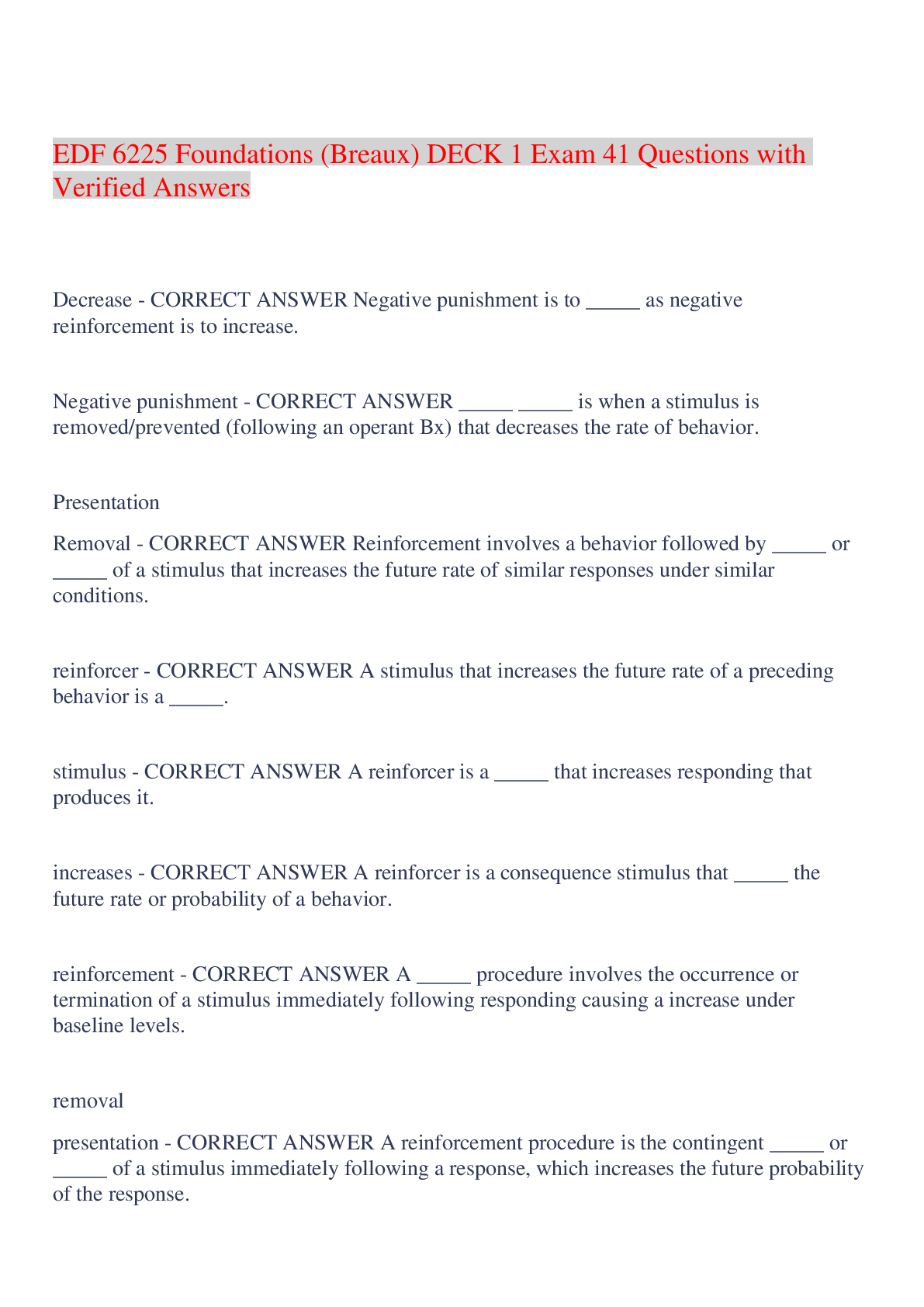*NURSING > EXAM > Rasmussen College: MDC III 1234/NUR2502 Exam 2 Focused Review LATEST 2021,100% CORRECT (All)
Rasmussen College: MDC III 1234/NUR2502 Exam 2 Focused Review LATEST 2021,100% CORRECT
Document Content and Description Below
Rasmussen College: MDC III 1234/NUR2502 Exam 2 Focused Review LATEST 2021 • Neck cancer- o S/S ▪ Pain ▪ Lump in mouth, throat or neck ▪ Difficulty swallowing ▪ Color changes in mouth ... ▪ Numbness of mouth, lips, or face ▪ Persistent, unilateral ear pain ▪ SOB ▪ Anorexia and weight loss o Nursing interventions ▪ Improve preoperational preparation ▪ Optimal in-hospice care ▪ Discharge planning and teaching ▪ Monitor gas exchange ▪ Assess RR and breath sounds Teach patient to use fowlers for best gas exchange o Treatment ▪ Surgery ▪ Radiation ▪ Chemotherapy ▪ Biotherapy o Teaching regarding treatment ▪ Weight gain is not a sign of neck cancer ▪ Radiation • Most patients have hoarseness, dysphagia, skin problems, and dry mouth for a few weeks after therapy • Hoarseness may become worse during therapy and difficulty swallowing • Gargle with saline or sucking ice may help • Avoid exposing the site to the sun • Use fluoride to prevent tooth decay ▪ Chemotherapy • Can be used with radiation and intensifies all the side effects of radiation • Breaks can occur due to the comfortability of the side effects, but it affects the outcome of the cancer so they do not recommend ▪ Biotherapy • Severe skin reactions are common and difficult for the patient • Nasal fractures- o S/S ▪ Unaligned nasal bridge, change in breathing, crackling of skin (crepitus), bruising, pain ▪ Blood or clear fluid (cerebrospinal fluid) leaking from nose indicates a serious skull fracture • Cerebrospinal fluid will contain glucose when tested with a dipstick o Treatment ▪ Closed reduction- realigning the bones by moving them from exterior within first 24 hours of injury ▪ Rhinoplasty- surgical reconstruction ▪ Nasoseptoplasty- submucous resection to fix blocked septum o Nursing interventions (including post op care and teachings) ▪ Cold compresses and pain relief for simple closed fractures to decrease swelling ▪ Manage the packing in both nostrils after rhinoplasty to prevent bleeding and support procedure ▪ Change the drip pad in place after rhinoplasty as necessary or teach patient how to ▪ Observe for edema and bleeding after surgery, vital signs q4h until discharge ▪ Educate to stay in semi fowlers and move slowly ▪ Educate to eat soft foods after anesthesia and drink 2500 mL/day ▪ Educate to decrease bleeding by limiting sniffing, coughing, or straining • Rhinosinusitis- o S/S ▪ Purulent drainage from both nares ▪ Fever ▪ Lack of response to decongestant therapy ▪ Pain over cheek ▪ Tenderness over sinuses ▪ Erythema ▪ Swelling ▪ Fatigue o Treatment or medical interventions ▪ Use of broad-spectrum antibiotics, analgesics for pain, decongestants ▪ Nasal saline irrigations ▪ Hot and wet packs ▪ Mast cell stabilizers ▪ Antipyretics o Diagnosis ▪ Made on basis of patients history and manifestations ▪ Sinus x-rays ▪ Endoscopic examination ▪ Computed tomography • Differentiating CSF from nasal drainage o Blood or clear fluid (cerebrospinal fluid) leaking from nose indicates a serious skull fracture o Cerebrospinal fluid will contain glucose when tested with a dipstick • COPD and oxygen o Cyanosis, delayed cap refill o Finger clubbing o Eating with mouth open; hard to breath with it closed o Potential complications ▪ Hypoxemia/ tissue anoxia • Obstructive sleep apnea- o Pathophysiology ▪ Breathing disruptions during sleep that lasts 10 seconds with a minimum of 5 times per hour ▪ During sleep, the muscles relax and the tongue is displaced ▪ Common cause is upper airway obstruction o Risk factors ▪ Obesity ▪ Large uvula ▪ Short neck ▪ Smoking ▪ Enlarged tonsils or adenoids ▪ Oropharyngeal edema o S/S ▪ Impaired gas exchange ▪ Increased blood CO2 levels and decreased pH ▪ Disrupted sleep cycle; exhaustion; day time sleepiness ▪ Irritability, personality changes ▪ o Treatment or medical interventions ▪ Overnight sleep study using EEG, ECG, EMG, pulse ox ▪ Position fixing devices may correct mild sleep apnea ▪ Noninvasive positive-pressure ventilation to hold open airway ▪ Nasal mask or full face mask (BiPAP or CPAP) ▪ Surgery to take out the uvula or adenoid could correct issue o Nursing interventions ▪ Have patient complete Epworth Sleepiness Scale (ESS)- 18 or above are at risk for severe sleep apnea o Complications ▪ HTN ▪ Stroke ▪ Neurocognitive deficits ▪ Weight gain ▪ Diabetes ▪ Pulmonary and cardiovascular disease • Non-invasive ventilation techniques o Using an oxygen mask to administer O2 and help prevent poor gas exchange o CPAP provide constant fixed positive pressure throughout inspiration and expiration causing airways to remain open o BiPAP provides differing airway pressure depending on inspiration and expiration. Inspiratory pressure is higher than than expiratory pressure o Negative pressure ventilation provides ventilatory support using a device that encases the thoracic cage • Epistaxis- treatment, nursing interventions o Pathophysiology ▪ Nosebleed due to many capillaries within nose o Treatment or medical interventions ▪ Anterior packing ▪ Nose plugs with blood clotting agent ▪ Gel tampon, posterior packing or epistaxis catheters used for posterior nasal bleeding o Nursing interventions ▪ Observe for respiratory distress ▪ Provide oxygen, bed rest and antibiotics that are prescribed ▪ Monitor for hypoxemia ▪ Apply ice or cool compresses to nose if possible ▪ Reassure patient and keep blood pressure lowered if possible • Asthma- o Pathophysiology ▪ Chronic, reversible airway obstruction only affecting the airways ▪ No issue with the alveoli ▪ Occurs in two ways: inflammation or airway hyperresponsiveness (sensitivity) leading to bronchoconstriction ▪ Smooth muscle contraction or edema, which leads to a narrow lumen o Risk factors ▪ General irritants ▪ Exercise ▪ Upper respiratory illness ▪ Aspirin and other NSAIDs ▪ GERD o S/S ▪ Audible wheeze, increase RR ▪ Increased cough ▪ Use of accessory muscles ▪ Barrel chest from air trapping ▪ Long breathing cycle ▪ Cyanosis ▪ Hypoxemia ▪ Tachycardia o Treatment or medical interventions ▪ Laboratory assessment • ABGs • Decreased PaO2 • PaCO2 may be normal or decreased at first ▪ Pulmonary function tests ▪ Drug therapy ▪ Positioning to high fowlers or tripod position to promote gas exchange ▪ Deep breathing and coughing exercises ▪ Get patient up and moving ▪ Oxygen therapy o Nursing interventions ▪ Improve air flow and gas exchange and relieve symptoms • Administer medications • Oxygen ▪ Self-management education • Personal asthma action plan • Assess PEF at least daily • Review chart 30-5 o Potential complications ▪ Status asthmaticus • Acute episode of airway obstruction • Can develop pneumothorax and cardiac/respiratory arrest o Prevent or treat complications ▪ Status asthmaticus- IV fluids, potent systemic bronchodilators, steroids, epinephrine, oxygen, magnesium sulfate (helps with opening airway) o Education ▪ Identify asthma action plan ▪ Assess asthma severity at least daily with a peak flow meter and to adjust drugs according to the action plan ▪ Establish peak expiratory flow to get a baseline ▪ Keep a symptoms and intervention diary to learn specific triggers of asthma, early cues for impending attack, and personal response to drugs • Dyspnea management in respiratory disorders • Dyspnea management in lung cancer o Place in fowlers to help ease breathing o Administer oxygen as prescribed and humidification to moisten and loosen secretions o Provide respiratory treatments o Provide activity as tolerated, rest periods, active and passive ROM • Bronchitis vs. emphysema (elaborate more??) o Emphysema ▪ Loss of lung elasticity and hyperinflation of lung o Chronic bronchitis ▪ Inflammation of bronchi and bronchioles caused by chronic exposure of irritants • Pneumonia- o Risk factors o S/S ▪ Older adult ▪ Never received pneumococcal vaccine ▪ No influenza vaccine year before ▪ Exposed to respiratory viral or influenza infections ▪ Chronic lung disease ▪ Altered LOC ▪ Recent aspiration event ▪ Poor nutritional status ▪ Receiving mechanical ventilation ▪ Edema ▪ Exudate ▪ Reduced gas exchange ▪ Hypoxia ▪ Empyema (pus in pleural cavity) ▪ Alveolar collapse (Atelectasis) ▪ Chest pain or discomfort ▪ Myalgia, HA, fever, chills ▪ Tachypnea ▪ Crackles during breath sounds o Treatment or medical interventions ▪ Antibiotics- azithromycin, tetracycline, doxycycline ▪ Cough suppressants ▪ Antipyretics, mucolytic agents, and expectorants o Diagnosis ▪ Sputum culture o Nursing interventions ▪ Teach proper handwashing, avoid large gatherings during cold and flu season ▪ Respiratory equipment needs to be cleaned and maintained/ decontaminated ▪ Oxygen therapy ▪ Have patient use incentive spirometer o Vaccinations ▪ 65+ receive pneumonia vaccine ▪ Have the annual influenza vaccine o Reduction of risk ▪ Avoid public places ▪ Handwashing ▪ Clean respiratory equipment ▪ Avoid outdoor pollutants ▪ Stop smoking ▪ Eat healthy diet ▪ Drink at least 3 liters of water a day • COPD – o Pathophysiology ▪ Emphysema • Loss of lung elasticity and hyperinflation of lung ▪ Chronic bronchitis o Risk factors • Inflammation of bronchi and bronchioles caused by chronic exposure of irritants o S/S ▪ Cigarette smoking ▪ Alpha 1- antitrypsin deficiency ▪ Asthma ▪ ▪ Thin with decreased muscle mass, slow moving, slightly stooped, tripod position ▪ Breathing rate and pattern ▪ Barrel chest ▪ Cyanosis, delayed cap refill ▪ Finger clubbing ▪ Swelling of feet and ankles due to right sided heart failure ▪ Eating with mouth open; hard to breath with it closed ▪ Hepatomegaly o Treatment or medical interventions ▪ Lab assessment • ABG values • Sputum samples • CBC • Hgb and Hematocrit • Electrolytes • Chest x-ray • Pulmonary function test ▪ Drug therapy ▪ Lung reduction surgery o Nursing interventions ▪ Improve gas exchange ▪ Reduction of CO2 retention ▪ Prevent weight loss and minimize anxiety ▪ Increase endurance ▪ Prevent respiratory infection ▪ Positioning ▪ Exercising conditioning ▪ Suctioning ▪ Hydration ▪ Vibratory positive pressure device ▪ Energy conservation education ▪ Nutrition o Potential complications ▪ Hypoxemia/ tissue anoxia ▪ Acidosis ▪ Respiratory infections ▪ Cardiac failure (cor pulmonale, which is right side heart failure) ▪ Cardiac dysrhythmias o Education ▪ Quit smoking and make referrals ▪ Weight loss can occur so ask to recall a typical day’s meals and fluid intake ▪ Teach to plan and pace daily activities with rest periods ▪ Avoid working with arms raised ▪ Don’t talk when engages in other activities that require energy ▪ Positioning upright with HOB elevated ▪ Exercise plan to increase pulmonary rehabilitation and to maintain adequate hydration ▪ Nebulizer treatments with normal saline or mucolytic agent to help thin secretions ▪ Coughing to remove excess mucus. Cough when waking up in the morning, before meal times, and before bedtime • Hug a pillow, sit down and turn shoulders in when coughing ▪ Breathing techniques to be used during all activities to reduce amount of stale air in lungs and manage dyspnea • Diaphragmatic- lie on back with knees bent, book on abdomen to create resistance, breathe and have book rise and fall • Pursed lip- breathe in through nose and out through kissy lips • Energy conservation in lower respiratory disorders o The planning and pacing of ADLs o Avoid working with arms raised o Keep arm movements smooth and flowing to prevent jerky movements o Organize work place so items used most often are within eay reach • Cystic fibrosis- o S/S ▪ Abdominal distention ▪ GERD ▪ Rectal prolapse ▪ Foul smelling stools ▪ Steatorrhea (fat in stools) ▪ Malnourishment ▪ Vitamin deficiency (ADEK) Fat soluble vitamin ▪ Respiratory infections ▪ Chest congestion and sputum production ▪ Decreased pulmonary function ▪ Limited exercise tolerance ▪ Increased WBC ▪ Decreased O2 stat ▪ Tachypnea ▪ Tachycardia ▪ Intercostal retractions ▪ Weight loss ▪ Increase fatigue o Treatment or medical interventions ▪ Nutritional management ▪ Drug therapy ▪ Infection prevention ▪ Pulmonary hygiene ▪ Exercise and nutrition ▪ Sweat chloride test- makes pt sweat and look at chloride in it ▪ Lung transplantation- extends life 1-15 years ▪ o Nursing interventions ▪ Enhance gas exchange ▪ Administer bronchodilators, anti-inflammatories, mucolytics and antibiotics ▪ Preventative/ maintenance therapy • Positive expiratory pressure • Active cycle breathing technique • Exercise program specified for patient o Diagnosis ▪ Sweat chloride test positive when it ranges between 60 and 200 mEq/L (normal value is 40) ▪ Genetic testing to determine specific mutation o Education ▪ There is no cure to this disease ▪ Teach to avoid hand shakes, large crowds, kissing people ▪ Teach that handwashing is critical ▪ Ways to help clear mucous • Chest physiotherapy uses chest percussion, chest vibration and dependent drainage to loosen secretions • Chest physiotherapy vest inflates and deflates to help cause mini-coughs that dislodge mucus from bronchial walls • Pulmonary fibrosis- o Pathophysiology ▪ Common restrictive lung disease with excessive wound healing with loss of cellular regulation ▪ Cigarette smoking, chronic exposure to inhalation or irritants o S/S ▪ Decreased gas exchange ▪ Dyspnea ▪ Decreased forced vital capacity ▪ Hypoxemia ▪ Rapid and shallow respirations o Treatment ▪ Corticosteroids ▪ Cytotoxic drugs • Respiratory medications o Bronchodilators- open up airways o Corticosteroids- inhibit cells involved in inflammatory purposes o Mast cell stabilizers- prohibit histamines, leukotrienes, and cytokines o Leukotriene receptor antagonists- block the effects of leukotrienes in inflammatory cascade o Antihistamines and epinephrine o Pulmonary surfactants o Antimicrobial and antivirals • Influenza- o S/S ▪ Fever ▪ Chills ▪ Fatigue ▪ Weakness ▪ Anorexia ▪ HA ▪ Muscle ache o Treatment or medical interventions ▪ Vaccinations are recommended ▪ Antivirals given o Nursing interventions ▪ Promote rest ▪ Increase fluid intake ▪ Gargle salt water ▪ Administer antihistamines ▪ Educate to wash hands • Pulmonary hypertension- o Pathophysiology ▪ Blood vessels constrict with increasing vascular resistance in the lung ▪ Occurs in absence in other lung disorders ▪ Caused by complication of other lung disorders ▪ Could be caused by exposure to some drugs such as fenfluramine/phentermine or dasatinib o S/S ▪ Dyspnea and fatigue doing normal activities ▪ Pulmonary blood pressure rises ▪ Blood flow decreases through lungs ▪ Poor perfusion and gas exchange ▪ Damage to the lungs and heart o Treatment or medical interventions ▪ Drug therapy • Warfarin • Calcium CB • Digoxin and diuretics • O2 therapy • Natural and synthetic prostacyclin agents • Endothelin-receptor antagonists o Complications ▪ Death occurs within 2 years after diagnosis ▪ Poor perfusion and gas exchange ▪ Cor pulmonale (remember SE of right side heart failure) ▪ Enlarged heart • Respiratory failure as a complication of respiratory disorders o Mismatched ventilation or perfusion o Acute failure can be ventilatory failure, oxygenation failure, or a combination of both ventilatory and oxygenation failure o PaO2 < 60 o PaCO2>45 o Always hypoxemic o Ventilatory failure ▪ Problem with intake ▪ Blood flow/perfusion is normal, but air movement is inadequate • Lung cancer- o S/S ▪ Hoarseness ▪ Cough ▪ Sputum production ▪ SOB ▪ Change in endurance ▪ Chest pain ▪ Labored or painful breathing ▪ Wheezing ▪ Dyspnea ▪ Respiratory distress ▪ Cardiac tamponade ▪ Dysrhythmias ▪ Bone pain or pathologic fractures ▪ Clubbing of fingers o Nursing interventions ▪ Teach patient about precautions to reduce risk of infection ▪ Monitor VS ▪ Relieve anxiety and promote patient’s participation ▪ Encourage to express fears and concerns, answer any questions and teach about the chest tube placement information ▪ Teach about probable locations for surgery ▪ Ensure the integrity of the system, promote comfort, ensure chest tube patency, and prevent complications ▪ Control pain for patient and educate on PCA devices o Palliative care ▪ Oxygen therapy ▪ Drug therapy ▪ Radiation therapy ▪ Thoracentesis r/t dyspnea, discomfort, risk for infection ▪ Pain management • Tuberculosis- o S/S ▪ Fatigue ▪ Lethargy ▪ N/V ▪ Anorexia (weight loss) ▪ Irregular menses ▪ Low-grade fever ▪ Night sweats ▪ Bloody cough ▪ Chest tightness o Treatments ▪ Antimicrobial therapy ▪ Combination drug therapy ▪ First line therapy drugs like isoniazid and pyrazinamide (8 weeks) ▪ Bedaquilline used for multidrug- resistant TB (deadly so give under observation) o Nursing interventions ▪ After sputum culture ordered, get the sample ▪ Place patient on airborne precautions ▪ Have patient wear mask in public ▪ Teach deep breathing, coughing, use of incentive spirometer ▪ Increase fluids ▪ Manage anxiety ▪ Improve nutrition (increase vitamins A,B,C,E, avoid alcohol, frequent small meals) ▪ Give antiemetics ▪ Manage fatigue and slow activity/get plenty of rest o Diagnosis ▪ Chest x-ray ▪ Nucleic acid amplification test. Results available less than 2 hours ▪ Blood analysis by enzyme- linked immunosorbent assay using QuantiFERON-TB Gold ▪ Sputum culture confirms the diagnosis ▪ The tuberculin test (Mantoux test) is the most reliable SCREENING test o Education ▪ Follow drug regimen ▪ Disease isn’t contagious after 2-3 weeks of drugs ▪ Proper nutrition to prevent weight loss ▪ Educate on TB, what it is, what the treatment is • Peritonsillar abscess- o S/S ▪ Collection of pus behind tonsil ▪ Swelling on one side of throat, pushing uvula toward unaffected side ▪ Severe throat pain ▪ Muffled voice ▪ Fever ▪ Difficulty swallowing ▪ Tonic contraction of the muscles of chewing ▪ Difficulty breathing ▪ Bad breath and swollen lymph nodes o Diagnosis ▪ Based on patients symptoms ▪ Needle aspiration and culture of pus collected is preferred test o Treatment ▪ Antibiotics ▪ Steroids ▪ Drainage of the abscess o Nursing Interventions ▪ Pain control through topical anesthetics, OTC analgesics and opioids o Education ▪ Stress importance of completing antibiotics completely ▪ Come to ED if symptoms of obstruction appear (drooling and stridor) ▪ Hospitalization needed when infection does not respond to antibiotics ▪ Tonsillectomy may be needed to prevent recurrence • Dosage and calculation [Show More]
Last updated: 2 years ago
Preview 1 out of 17 pages

Buy this document to get the full access instantly
Instant Download Access after purchase
Buy NowInstant download
We Accept:

Reviews( 0 )
$15.00
Can't find what you want? Try our AI powered Search
Document information
Connected school, study & course
About the document
Uploaded On
Feb 24, 2022
Number of pages
17
Written in
Additional information
This document has been written for:
Uploaded
Feb 24, 2022
Downloads
0
Views
84


